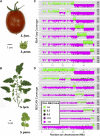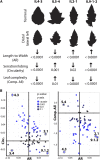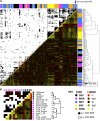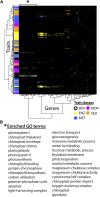A quantitative genetic basis for leaf morphology in a set of precisely defined tomato introgression lines
- PMID: 23872539
- PMCID: PMC3753377
- DOI: 10.1105/tpc.113.112391
A quantitative genetic basis for leaf morphology in a set of precisely defined tomato introgression lines
Abstract
Introgression lines (ILs), in which genetic material from wild tomato species is introgressed into a domesticated background, have been used extensively in tomato (Solanum lycopersicum) improvement. Here, we genotype an IL population derived from the wild desert tomato Solanum pennellii at ultrahigh density, providing the exact gene content harbored by each line. To take advantage of this information, we determine IL phenotypes for a suite of vegetative traits, ranging from leaf complexity, shape, and size to cellular traits, such as stomatal density and epidermal cell phenotypes. Elliptical Fourier descriptors on leaflet outlines provide a global analysis of highly heritable, intricate aspects of leaf morphology. We also demonstrate constraints between leaflet size and leaf complexity, pavement cell size, and stomatal density and show independent segregation of traits previously assumed to be genetically coregulated. Meta-analysis of previously measured traits in the ILs shows an unexpected relationship between leaf morphology and fruit sugar levels, which RNA-Seq data suggest may be attributable to genetically coregulated changes in fruit morphology or the impact of leaf shape on photosynthesis. Together, our results both improve upon the utility of an important genetic resource and attest to a complex, genetic basis for differences in leaf morphology between natural populations.
Figures





Comment in
-
A quantitative genetic basis for leaf morphology is revealed in a set of precisely defined tomato introgression lines.Plant Cell. 2013 Jul;25(7):2379. doi: 10.1105/tpc.113.250710. Epub 2013 Jul 19. Plant Cell. 2013. PMID: 23872537 Free PMC article. No abstract available.
References
-
- Abramoff M.D., Magelhaes P.J., Ram S.J. (2004). Image processing with ImageJ. Biophotonics International 11: 36–42
-
- Bailey I.W., Sinnott E.W. (1915). A botanical index of Cretaceous and Tertiary climates. Science 41: 831–834 - PubMed
-
- Barkoulas M., Galinha C., Grigg S.P., Tsiantis M. (2007). From genes to shape: Regulatory interactions in leaf development. Curr. Opin. Plant Biol. 10: 660–666 - PubMed
-
- Baxter C.J., Carrari F., Bauke A., Overy S., Hill S.A., Quick P.W., Fernie A.R., Sweetlove L.J. (2005). Fruit carbohydrate metabolism in an introgression line of tomato with increased fruit soluble solids. Plant Cell Physiol. 46: 425–437 - PubMed
-
- Benjamini Y., Hochberg Y. (1995). Controlling the false discovery rate: A practical and powerful approach to multiple testing. J. R. Stat. Soc. B 57: 289–300
Publication types
MeSH terms
Substances
LinkOut - more resources
Full Text Sources
Other Literature Sources

